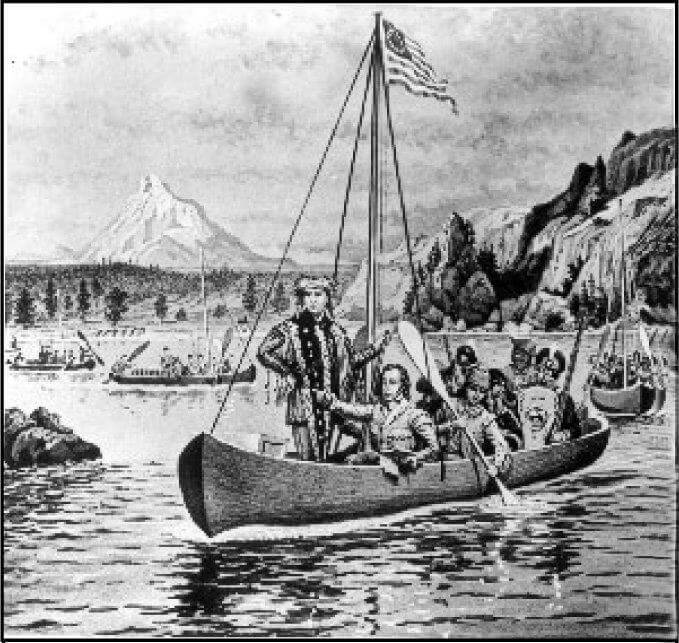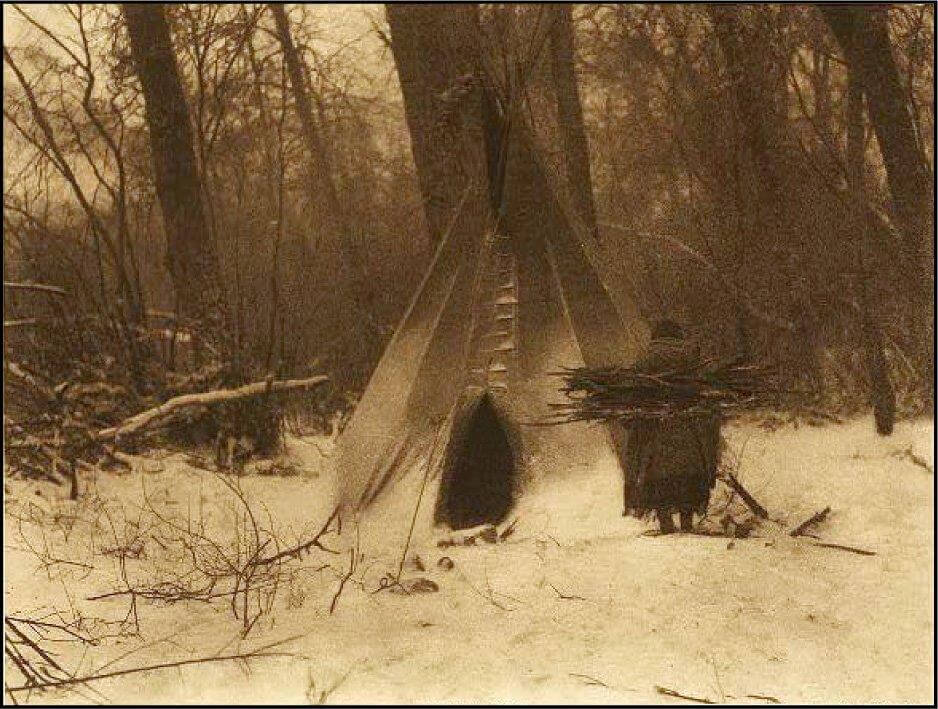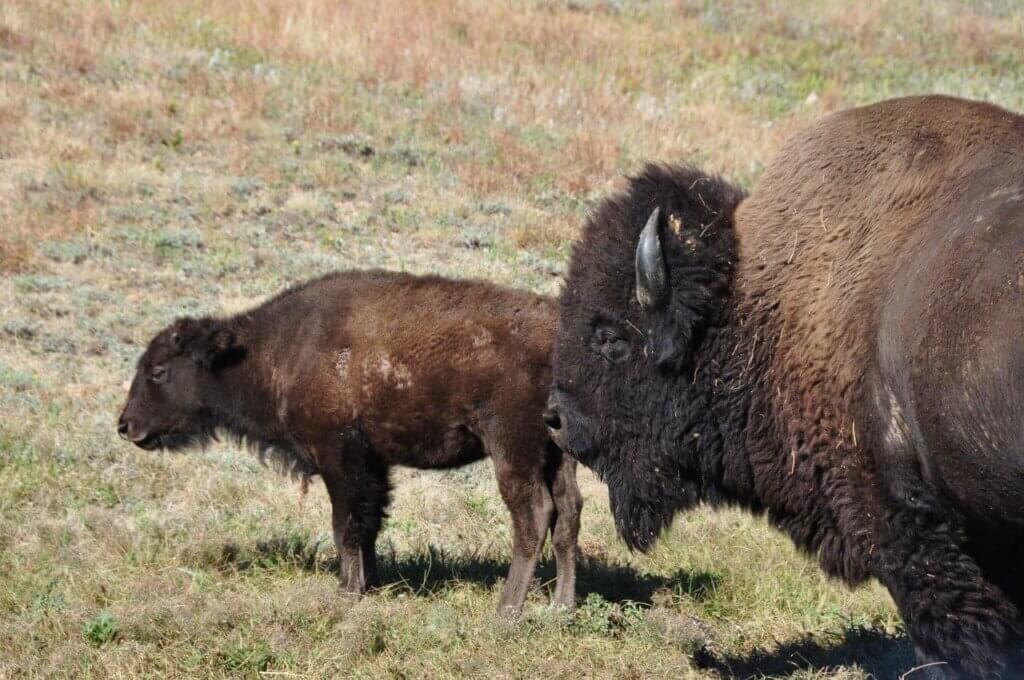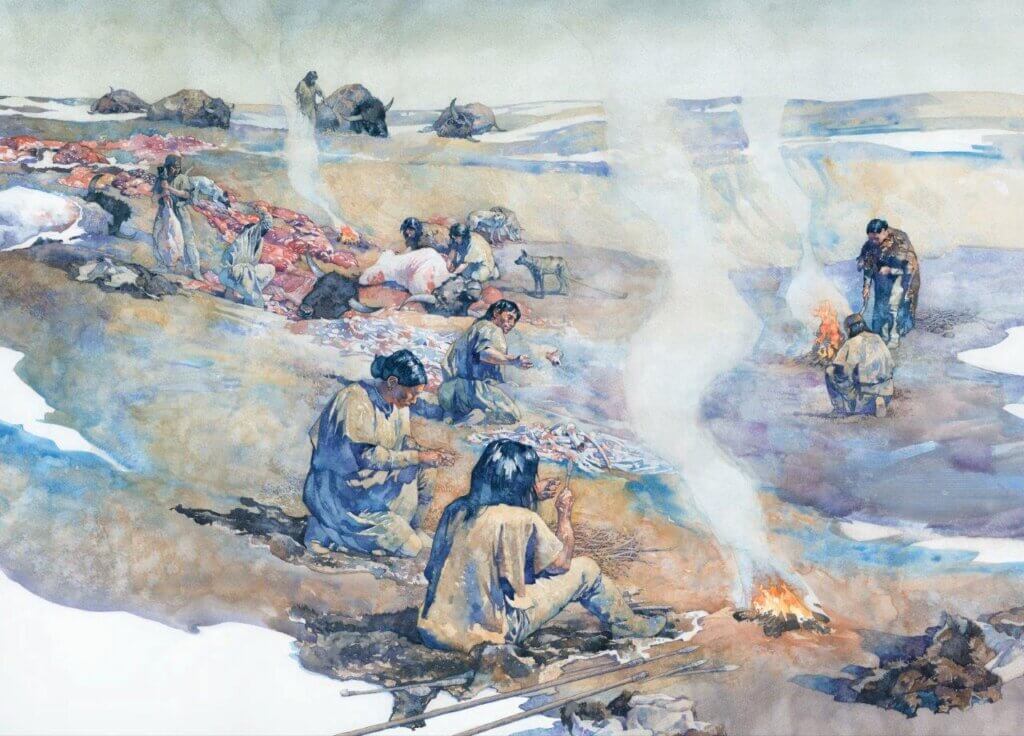Doing Math on Plains Indian Diets, by Gene Gade

An artist’s image of the pirogues and canoes that the Lewis and Clark crew paddled and dragged up the Missouri River in 1805.
“The men’s labor was again such that each private ate as much as 9 or 10 pounds of meat per day.”
So historian Stephen Ambrose described the food requirements and diets of the members of the Lewis and Clark expedition in April of 1805 in his prize-winning book, “Undaunted Courage.”
The men were working hard, paddling or sometimes dragging heavily-laden canoes for 20 miles or more per day up the Missouri River, against the current and prevailing wind.
When not with the boats, they were walking even greater distances over the prairie. The 30 or so members of the expedition ate a few roots and other edible plant parts (usually provided by Sacagawea), but the vast majority of their diet was meat. The famished group consumed about 300 pounds of meat every day!
It’s useful to consider this example when one thinks about the nutritional requirements and diets of the Plains Indians and their use of the Vore Buffalo Jump.
Buffalo “jumps” were usually conducted in autumn with the goal of obtaining enough meat and hides to provide for tribal needs during harsh winters. If a winter proved mild and hunting conditions were favorable, men could provide fresh meat.
However, quantities of dried meat and pemmican were needed as supplements during most winters and were an emergency meat supply when the winter was severe and hunting was difficult or impossible.

Winter camps were usually along sheltered river valleys and camp chores were constant and strenuous. This Edward Curtis photo shows a Crow woman carrying a load of firewood to a tipi in winter.
In very successful communal hunts at the Vore site, 200 to 300 bison were sometimes killed. That’s tons of meat. Could they really eat that much meat? Wasn’t there a great deal of waste?
Is it possible, or healthy, for humans to be almost totally carnivorous for their entire lives? Let’s let modern science help us find the answers to these and other questions.
How much Meat was Available from a Vore Site Hunt?
Most hunts at the Vore site occurred in the fall, after the bison breeding season. When breeding is finished in August and September, buffalo bulls often wander away, leaving herds of predominantly cows and calves. When a “jump” occurred, the herd would consist of mostly mature female bison, some yearling or 2-year-old females, calves from the previous spring and a few lingering bulls.
Bulls often weighed 1,500 to 2,000 pounds (the very biggest weigh a ton and a half!). Mature females tip the scales at 1,000 to 1,400 pounds, probably averaging about 1,200. Two-year-old bred-heifers weigh about 900. Yearling heifers are about 750 pounds. Calves in that season will weigh 450 to 575 pounds, depending on gender, say 500 pounds on average.
Let’s assume a herd of 100 animals comprised of 40% mature females, 10% two-year-old bred heifers, 15% yearling heifers, 15% calves and 10% bulls. Using average weights for those animals, its reasonable to assume that the total weight of that herd would be about 86,500 pounds or 43.5 tons as live weight.

Hunts in the fall after breeding season meant herds of mostly cows and calves with young bulls and females, and a few lingering bulls. Photo Chris Hull, SD GFP.
On really successful hunts at the Vore site, the Indians may have killed two to three times that many animals.
About 60% of a carcass would be useable (recoverable muscle meat and organs) with the hide and skeleton accounting for the other 40%. Given our assumptions, that means the yield from a typical herd of 100 buffalo would be about 51,900 pounds of meat (25.95 tons) plus 3 to 4 tons each of marrow bones and hide.
The rest of the carcasses, (15-25% of the total original weight, mostly non-marrow bones) were left behind. These are the remnants archaeologists find and analyze at the Vore site.
Calories Available vs. Required
If a person doesn’t get out of bed or do any physical work, he/she will still “burn” calories as the body performs basic functions like breathing, digesting, pumping blood, thinking and maintaining normal body temperature. This is called “basal metabolism” and it varies according to the size, age and gender of the person in question.
Let’s take a 30-year-old male Indian who is 5’10” tall and weighs 166 pounds. If he did nothing at all, he would still require about 1,790 calories daily to maintain basic life functions. Likewise, a woman of the same age who was 5’5” and 125 pounds would need approximately 1,365 calories per day for maintenance.
If you add physical activity (exercise), to the energy equation, the caloric requirement increases. Hunting, butchering and processing buffalo is hard work. Using our male Indian from the previous example, if he were completing strenuous work required during the buffalo hunt and its aftermath, his total estimated energy expenditure (TEE) would be between 3,940 to 4,725 calories. The woman in our earlier example would have a TEE value of 3,000 to 3,600 calories daily. Adolescent requirements are similar to adult women. A child (10 years old) would require up to 3,000 calories. These values are what is needed to maintain body weight.
If weight gain was desired or growth in stature was occurring, these values would need to increase by about 500 calories a day! Pregnancy, lactation and other variables can also increase caloric requirements.
So How Much Meat is Required?
The caloric content of meat varies with the tissue and fat content, but according to the US Department of Agriculture lean, raw buffalo meat provides about 496 calories per pound. Cooking lowers the nutritional content slightly, providing about 445 calories per raw pound. Assuming our hypothetical hunter only consumed cooked buffalo meat he would require up to 10.6 pounds daily to meet his TEE calorie recommendation.
A hunter probably wouldn’t carry that much meat with him and couldn’t have consumed it even if it were available. So he’d either have to consume a more calorie-rich food or he’d lose weight fairly quickly. Probably he’d do both in the days leading up to and following the “jump.”
Let’s follow one of the hunters through a hypothetical hunt at the Vore Buffalo Jump.
First, if he participated in gathering the herd, our young man would be sent out several days prior to the “jump” to find and collect a critical mass of bison. It’s likely that he’d be walking fast or running for at least 12 hours per day.
After driving the buffalo over the “jump,” another very strenuous phase would begin immediately. The Indians butchered the bison which involved skinning and cutting them into transportable chunks that were easy to move quickly before the meat spoiled.
They had, perhaps, a 3 to 5 day period to butcher 60 to 300 buffalo. They undoubtedly worked in teams from dawn to dark (at least 9 to 10 hours) per day in late-autumn.

After the kill, hunters had perhaps a 3 to 5 day window to butcher 60 to 300 buffalo. This meant at least 9 to 10 hours of hard work for all, per day. Early peoples poster, ND State Historical Society.
They’d pull a carcass out of the pile, skin it, remove the entrails and internal organs and chop the skeleton and associated muscles apart at the joints.
If they trapped 200 bison in a communal hunt, they’d have to butcher an average of 40 carcasses daily for five days. Perhaps 100 people would be involved in the butchering and they probably worked in teams of four to six persons per carcass at a given time. If they had five people on a team, then each team would need to completely butcher at least two bison a day.
Transporting the tons of meat, bone and hide from the Vore site to a processing camp may well have been the job of adolescents, using dogs with drags (travois) to help. This task would have involved numerous trips into and out of the sinkhole carrying heavy loads and probably many round trips from the jump site to the main camp each day. The camp was probably one to three miles away over broken terrain. This too used a lot of energy by both youth and dogs, with the primary fuel being meat.
Finally, there was the enormous task of processing all of the meat into products that concentrated the nutrients and that would last for at least a few months without refrigeration.
The hides were tanned via an arduous multistep process involving scraping, soaking and stretching of the hide, removal of the hair in most cases, and a treatment with brain tissue to keep the leather soft and pliable. These tasks probably required every able-bodied woman working full time for a couple of weeks.
From the time the small, scattered hunting groups came together for the communal hunt through the jump, butchering and processing phases, it is likely 300 Indians would have been working hard on the endeavor for two to three weeks.
Assuming this group is divided roughly in thirds…1/3 men, 1/3 women and 1/3 children…there would be approximately 100 in each group. Using the TEE values discussed earlier, the communal hunt itself possibly required up to 1.1 million calories daily for the group to maintain its current body weight.
This would amount to nearly 20 million total calories if they were working together for 18 days at this high intensity level. Just that effort would require the equivalent of about 45,000 pounds of cooked buffalo meat. That’s just priming the pump. The meat supply from this and other jumps may have been needed to keep these three hundred folks alive for four months or more in a bad winter.
Activity may not have been so intense and strenuous on a daily basis during the routine of a winter camp, but men may still have walked many miles a day to hunt. If successful, they had to partially butcher the carcass and carry the game home. Women and children still had heavy duty with camp chores.
Also, the environment in which they were living (including extremes of temperature) increased physical stress that could lead to a higher energy requirement.
Let’s not forget the dogs. They were working animals and probably needed several pounds of meat per animal daily as well.
All totaled, it would be surprising if the group and dogs involved in the hunt didn’t require a minimum of 875,000 calories per day (about 1,965 pounds of cooked buffalo meat).
If a hard winter came, as it inevitably would, and the Indians needed to stay close to camp for four months with minimal supplemental hunting, the group and their dogs would have used over 100 million calories (equal to about 240,000 pounds of cooked lean meat or 100 tons!). Recall our estimate that if they killed 100 bison in a hunt at the Vore site, the yield would be about 26 tons of raw meat providing up to 23 million calories!
We’ve answered the first two questions. How much meat was required? Some winters the requirement was 4 to 6 times more than a successful buffalo jump would likely produce. Would there have been a lot of waste? No, the Plains tribes needed large quantities of meat and used what they ac[1]quired as efficiently as possible.
A Nutritional Puzzle
A final interesting question remains: Is an almost totally carnivorous diet healthy and sustainable?
Any one of the three major energy nutrients of our food: carbohydrates, fats and proteins, can be broken down to produce the energy required by our bodies. Fat offers the most energy (9 calories per gram) while carbohydrates and proteins are equal (4 calories per gram).
Carbohydrates are the body’s preferred source of energy. Once carbohydrate stores are depleted the body starts to breakdown stored fat into a usable form of energy. As fat stores become depleted the body begins to breakdown stored protein. The protein is often taken from the muscles where it is stored. When stored protein is used for energy the body begins to make higher levels of ketones and ammonia, which can become toxic.
Proteins are large molecules composed of smaller sub-units called amino acids. The “amine” groups that give these compounds their name contain nitrogen (as –NH2). To use protein for energy, it must first be reduced to amino acids and the amine groups have to be removed. The amines are filtered from the blood via the kidneys and excreted in the form of urea.
Research has shown that low carbohydrate diets supplemented with high fat and protein may lead to reduced vitamin and mineral intakes, increased risk of heart disease, kidney disease, fatty liver and bone loss.
Current nutrition recommendations encourage 45-50% of calories from carbohydrates, 15-20% from protein and 20-25% from fat. This diet composition has been shown to reduce risk of heart disease.
It is clear that Plains Indians could not have functioned as they did exclusively on the lean muscle meat from buffalo. It would not have provided them with adequate carbohydrates, vitamins or minerals. The high protein content would have likely led to intestinal complaints and gout as well.
The tribes did consume some carbohydrates in the form of tubers and roots, and fruit such as berries. These foods provide about 15 grams of carbohydrate (60 calories) per serving. Also, some tribes, like those that lived in earthlodge villages along the Missouri River grew corn, beans, squash, sunflowers, amaranth and other crops, but hunted buffalo and other wild animals as well. Many of the more nomadic Plains tribes are known to have traded with their farming neighbors or relatives, exchanging meat and hides for corn, among other items.
In any case, the over-all diet of the Plains hunters was very low in carbohydrate and fat was used as the primary source of calories. Excavation at the Vore site as well as abundant evidence from other sources support this observation.
Nearly all of the bison bones were broken open so the marrow could be used. The marrow pulp is rich in fat, proteins and calories that could be extracted or rendered from the bones.
The pemmican “sausage” that was used by the Indians as a high-energy food concentrate was a combination of pounded dry muscle meat mixed with a high quantity of fat from the marrow or from around the buffalo organs and, sometimes, dried berries added for flavor, texture, sugar
The Perfect Atkins Diet?

Buffalo steak, just as delicious today as over an ancient campfire. Photo courtesy of National Bison Assoc.
The late Dr. Robert Atkins gained fame for his promotion of a diet that emphasized very low carbohydrate intake and essentially unlimited protein and fat from meat.
Atkins claimed that sugars and starches (the two most common forms of carbohydrate in the American diet) are the primary cause of problems such as obesity and diabetes. Atkin’s theory was that carbohydrates should be minimized, forcing the body to meet its energy requirement from metabolism of fats and proteins.
Historical evidence indicates that many, primarily carnivorous, Indians functioned well and lived relatively long lives. Its interesting to compare a Plains Indian traditional diet that was high in fat and protein and low in carbohydrate to that of current diet recommendations which emphasize low fat and moderate intakes of lean protein and complex carbohydrates.
Today’s dietary recommendations are directed towards preventing chronic disease and achieving longevity while the Plains Indian diet was likely designed for day-to-day survival. Today, food is readily available in most developed countries, reducing the need to store excess energy as fat.
In comparison, the fat consumed by the Plains tribes was able to sustain them during inevitable times of famine. Additionally, energy needs in our current society are likely lower due to reduced physical activity levels.
The traditional high calorie, high fat diets of Plains Indians likely worked because of their high activity level which is an effective means of keeping blood vessels healthy and maintaining a balance between energy intake and expenditure.
Questions remain as to how the traditional Plains Indian diet affected general long-term health and longevity. The answers to these and similar questions are not completely known and need to be researched. Archaeological evidence from the Vore site can contribute to our understanding of such questions.
Related Buffalo Hunting Information from the Author
Plant Foods in Plains Indian Diets
Although Plains Indians ate primarily lean meat, they did supplement their diet with portions of many plant species. Some plant materials were consumed seasonally, others were dried, stored and used year-round. Here’s a partial list:
Tubers and Roots—Arrowhead, yampa, balsam root, scurfpea, wild onion, mariposa/sego Lily, evening primrose;
Stems– some thistles, cattails;
Leaves– Fireweed and many other plants used as “salad”;
Seeds-Sunflower, amaranth, Indian ricegrass;
Fruits-Cactus fruits, strawberries, Oregon grape, buffaloberry, huckleberry, currants, gooseberry, acorns, serviceberry, wild plum, sand cherry, chokecherry, wild rosehips, raspberry, thimbleberry and river grape.
Hundreds of other plant products were used as medicines.
Today’s Buffalo Meat
The nutrient analysis for cooked buffalo meat from one pound raw is: 445 Calories
97.6 grams of protein (87.7% of total calories)
8 grams of fat (16.2% of total calories)
0 grams of carbohydrate
Note: one pound = 454 grams. The unaccounted for mass is primarily water and minerals.
What’s the 2008 market value of a Vore site hunt?
Some representative prices found on the Internet:
Buffalo Meat—Hamburger, one pound = $4.50 to $6.50; Steaks, one pound = $9 to $25 depending on cut; Brats (similar to pemmican), $15 per pound; Buffalo jerky, one pound =$40.
Buffalo Hide Products—Buffalo robes commonly sell now for $900 to $1,500 each, depending on size. Heavy, decorated buffalo hide coats sell for up to $3,500. Fancy gloves = $75 to $150.
Skulls—Decorated skulls go for $500 to $1,000 each. Mounted trophy bull heads sell for about $2,000 to $2,500 each.
100 buffalo = 26 tons of meat. Assuming an average price of $9 per pound. Total value = $468,000;
100 robes at $1,000 each = $100,000. Decorated skulls and/or mounted heads, 25 at $1,500 each = $37,500.
Very conservatively, products from a moderately successful hunt at the Vore site = $700,000!
Sources:
(italic) Frary, C.D. & Johnson, R.K. (2004). Energy. In Mahan, L.K., Escott-Stump, S. (Eds.), Krause’s Food, Nutrition and Diet Therapy (11th ed.). WB Saunders Company. Philadelphia, PA. pp. 21-36
Harris J, Benedict F.1918. “A Biometric Study of Human Basal Metabolism”. Proc Natl Acad Sci USA 4 (12): 370-3.
National Nutrient Data Base for Standard Reference. USDA. Ag. Research Service. http://www.ars.usda/ nutrientdata
Grateful acknowledgement is due several people who reviewed this article and provided specific editorial suggestions. These individuals included Jacqueline Wyatt, Jan Truchot, Muriel and Caitlin Gade and, especially, Sarah L. Francis PhD, MHS, RD.
Gene Gade, the author of many well-researched articles in the Vore Buffalo Jump newsletter took the job as County Extension Agent in Sundance Wyoming many years ago. When the Vore sinkhole literally “fell in their laps” he must have thought to himself from his County Agent vantage position, “‘I know how to do this; I need to help.” And he put in over 20 years as president of the non-profit VBJ Foundation. From his extensive USDA Extension connections he helped to develop and guide the research, education and economic potentials of the Vore site for all those years.
We thank the non-profit Vore Buffalo Jump Foundation for generously allowing us to reprint these educational articles about Buffalo hunting and the Vore site in Wyoming. Donations and comments may be sent to: Vore Buffalo Jump Foundation; 369 Old U.S. 14; Sundance, WY 82729; Tel: (307) 266-9530; Email: info@vorebuffalojump.org

Francie M Berg
Author of the Buffalo Tales &Trails blog


